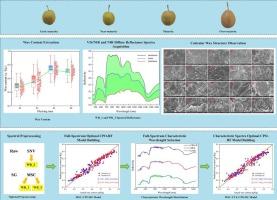Microscopic changes and quantitative prediction of wax content in the peel of Korla fragrant pear at different picking maturities
IF 9.8
1区 农林科学
Q1 CHEMISTRY, APPLIED
引用次数: 0
Abstract
Peel wax of Korla fragrant pears plays a crucial role in preserving shelf life and quality by acting as a protective barrier. This study established a non-destructive method for quantifying epicuticular wax content in Korla fragrant pears by integrating visible and near-infrared (VIS/NIR) spectroscopy with a Crested Porcupine Optimizer–Random Forest (CPO–RF) model. Microstructural analysis indicated progressive densification of the wax layer during fruit maturation, which was strongly correlated with wax accumulation. The optimized CPO–RF model employing multiplicative scatter correction and full-spectrum data achieved superior predictive performance, with a prediction coefficient of determination () of 0.9468 and a root mean square error of prediction () of 0.0301 g/Kg. A feature-wavelength model based on uninformative variable elimination also exhibited excellent results ( of 0.9390, of 0.0330 g/Kg), demonstrating potential for rapid, intelligent quality assessment and enhanced postharvest management of Korla fragrant pears.

库尔勒香梨不同采摘期果皮蜡含量的微观变化及定量预测
库尔勒香梨皮蜡作为一种保护屏障,对保持香梨的保质期和品质起着至关重要的作用。采用冠豪猪优化-随机森林(CPO-RF)模型,建立了库尔勒香梨果皮蜡含量的可见和近红外(VIS/NIR)光谱综合无损定量方法。显微结构分析表明,果实成熟过程中蜡层逐渐致密化,这与蜡积累密切相关。采用乘性散射校正和全谱数据优化后的CPO-RF模型预测效果较好,预测决定系数(Rₚ2)为0.9468,预测均方根误差(RMSEₚ)为0.0301 g/Kg。基于无信息变量消去的特征波长模型也取得了较好的结果(R =ₚ2 = 0.9390,RMSE =ₚ= 0.0330 g/Kg),为库尔勒香梨品质的快速智能评价和采后管理提供了潜力。
本文章由计算机程序翻译,如有差异,请以英文原文为准。
求助全文
约1分钟内获得全文
求助全文
来源期刊

Food Chemistry
工程技术-食品科技
CiteScore
16.30
自引率
10.20%
发文量
3130
审稿时长
122 days
期刊介绍:
Food Chemistry publishes original research papers dealing with the advancement of the chemistry and biochemistry of foods or the analytical methods/ approach used. All papers should focus on the novelty of the research carried out.
 求助内容:
求助内容: 应助结果提醒方式:
应助结果提醒方式:


